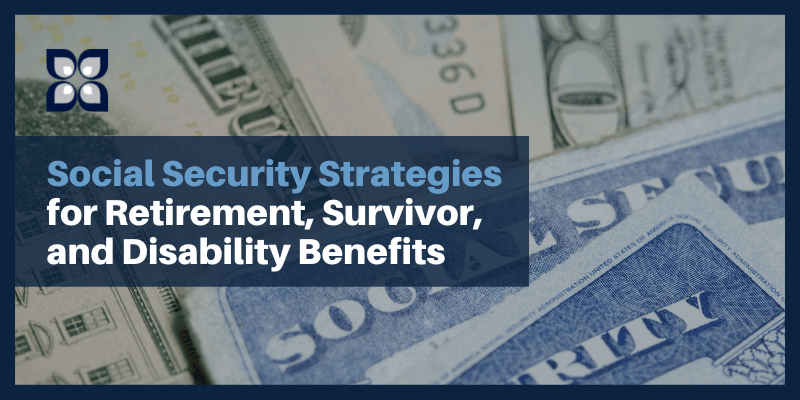Social Security is a complex topic, ranging from understanding the different types of benefits, eligibility qualifications, and strategies to maximizing lifetime benefits for an individual or between spouses. Many times, people do not consider the impact their collecting choice will have on their spouse, or vice versa. While these strategies are valuable tools to use in your Social Security claiming strategy, they need to be implemented strategically to optimize results. You only get one opportunity to make the right decision.
The tools discussed below will explore topics to provide a reference guide in understanding possible options. Several terms that are used frequently throughout are: (1) FRA refers to Full Retirement Age, which is age 66 to age 67 and represents the age at which a worker is entitled to a full benefit, and (2) PIA refers to Primary Insurance Amount, which is the full benefit at a worker’s Full Retirement Age.
While there are many different benefit options, we will explore the retirement, survivor, and disability benefits in this article. Each of these has their own set of rules and eligibility requirements.
Retirement Benefits
To qualify for retirement benefits, a worker needs a total of 40 work credits. A maximum of 1 credit is earned each quarter (4 per year) if FICA earnings are at least $1,510 (2022 dollar amount). The amount of earnings needed for a quarter of coverage changes each year with the national average wage index. A maximum of four (4) credits can be earned annually (minimum of $6,040 of earnings in 2022 to achieve all 4 credits); this equates to a total of 10 years of part-time work history required to become eligible for benefits (assuming the minimum earnings level was achieved each year). The higher your average Social Security-taxed wages, the higher your benefit. The largest retirement benefit payable at FRA is about $3,345 for an individual born in 1959. For year 2022, the wage base for which Social Security taxes are withheld tops out at $147,000.
Since Social Security maintains a  historical record of a worker’s earnings and the average indexed monthly earnings (AIME) are the basis for computing a retirement benefit, it is very important that a worker obtain an annual copy of their “Your Social Security Statement” to verify that the correct earnings are being reported. In order to obtain a statement, you need to go to www.ssa.gov and establish a My Social Security Account. Once a worker reaches age 60, the SSA will automatically send a statement each year. The statement provides valuable information such as current estimated benefit, explanation of benefit calculation, and your earnings record. It is the responsibility of all workers to help keep their earnings record accurate. Any errors should be reported to the SSA.
historical record of a worker’s earnings and the average indexed monthly earnings (AIME) are the basis for computing a retirement benefit, it is very important that a worker obtain an annual copy of their “Your Social Security Statement” to verify that the correct earnings are being reported. In order to obtain a statement, you need to go to www.ssa.gov and establish a My Social Security Account. Once a worker reaches age 60, the SSA will automatically send a statement each year. The statement provides valuable information such as current estimated benefit, explanation of benefit calculation, and your earnings record. It is the responsibility of all workers to help keep their earnings record accurate. Any errors should be reported to the SSA.
The earliest a worker becomes eligible for retirement benefits is age 62, and the latest is age 70. A full benefit is payable at FRA, which is age 66 to age 67, depending on year of birth. Benefits started prior to FRA will be reduced (up to 30% at age 62) and benefits postponed beyond FRA will be increased (up to 32% for age 70 or 8% per year!). If you do not need the money and health is on your side, it may behoove you to postpone taking benefits but there are spousal options to consider as well.
Some planning considerations include: your expected longevity, do you need the money today, what other sources of income and assets you have, what is your spouse eligible for and when, tax bracket today vs. the expected future, retirement account Required Minimum Distributions, etc. Please speak with your advisor about your unique circumstances to plan the most effective strategy.
Survivor Benefits
A surviving spouse can qualify for benefits on the deceased spouse’s record (either current spouse or ex-spouse) if they meet the following requirements:
- Age 60 or above (or any age if caring for the deceased’s child who is under age 16 or disabled and receiving child’s benefits).
- Deceased spouse must have sufficient work credits (credits needed = age at death minus 22).
- Duration of marriage must be at least 9 months (current spouse) or 10 years (ex-spouse). If you remarry after turning age 60 (50 if disabled), benefits will continue. If you remarry prior to age 60, you lose eligibility for benefits and regain eligibility ONLY if the subsequent marriage ends through death, divorce, or annulment.
A surviving spouse has the flexibility to choose whether to begin widow/widower benefits as early as age 60 (age 50 if disabled) or late as FRA and can choose to start his/her own benefits as early as age 62 or as late as age 70. If benefits begin prior to FRA, reductions range anywhere from 1% to 28.5%.
Neither Spouse Started Benefits – If the surviving spouse waits until FRA, they will receive 100% of the deceased spouse’s PIA. If the deceased spouse was older than FRA, the survivor benefit includes the delayed credits.
One or Both Spouses Started Benefits – if both spouses were collecting, the surviving spouse will continue to receive the larger of the two benefits. If the deceased spouse started but not you, you could choose a survivor benefit now and then switch to your own benefit as late as age 70 (if larger at that point). Alternatively, the collecting order could be reversed, i.e., choose own benefit now and switch to the survivor benefit at FRA.
Disability Benefits
A disabled worker can receive a disability benefit if they meet the following requirements:
- Unable to work or perform Substantial Gainful Activity (not to exceed earnings of $1,350/month if non-blind or $2,260/month if blind).
- Must have a specified minimum number of work credits/quarters of coverage.
- Must be under full retirement age.
- Must have one of the disabilities as defined by Social Security.
The younger you are, the fewer quarters of coverage you need. Medical evidence from a physician is not required to apply, although a disability report will need to be completed, showing date of onset, last date worked, name, address, and dates of visits to hospitals, doctors, etc. Disability benefit eligibility is reviewed periodically from a medical perspective and ability to work perspective and could result in either a continuation or termination of benefits.
Application Process
There are three ways to apply for any social security benefits:
- Online at www.ssa.gov or www.socialsecurity.gov. You will need to establish a My Social Security Account.
- Visit your local SS field office.
- Call 1-800-772-1213 and speak with an SS customer service representative or schedule a phone appointment or appointment at the local office.
The easiest and best way to apply is online. If going to apply in person, be prepared for a long wait in line at a local office!
Additional information can be obtained by referencing the following publications posted on the Social Security website: The Social Security Handbook and the POMS (Program Operations Manual System).
How Mission Wealth Can Help
When it comes time to evaluating and selecting an ideal collecting strategy, an individual should consult with a financial advisor that can prepare an in-depth analysis of the various Social Security claiming strategies. Our Mission Wealth clients benefit from compliance specialists, Greg Smith who is a holder of the National Social Security Advisor Certificate. Greg provides special expertise to clients regarding determining optimal collecting strategies.
If you don't have an advisor but would like to learn more, you can contact us by phone or via our website and an advisor will be in touch. Please visit www.missionwealth.com to learn more.
All information is sourced from reliable sources but please cross check your specific situation with a certified Social Security advisor before implementing or delaying any plan as unique circumstances may pertain to you.
Copyright © 2022, Mission Wealth is a Registered Investment Advisor. All rights reserved.
ALL INFORMATION HEREIN HAS BEEN PREPARED SOLELY FOR INFORMATIONAL PURPOSES. ADVISORY SERVICES ARE ONLY OFFERED TO CLIENTS OR PROSPECTIVE CLIENTS WHERE MISSION WEALTH AND ITS REPRESENTATIVES ARE PROPERLY LICENSED OR EXEMPT FROM LICENSURE. PAST PERFORMANCE IS NO GUARANTEE OF FUTURE RETURNS. INVESTING INVOLVES RISK AND POSSIBLE LOSS OF PRINCIPAL CAPITAL. NO ADVICE MAY BE RENDERED BY MISSION WEALTH UNLESS A CLIENT SERVICE AGREEMENT IS IN PLACE.
00465157 09/22


